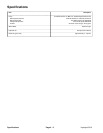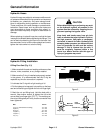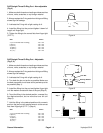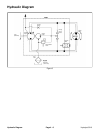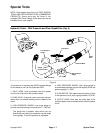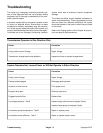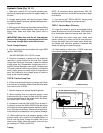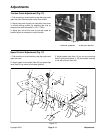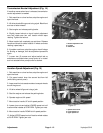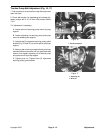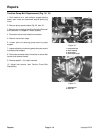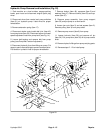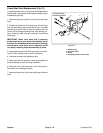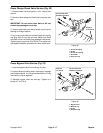
Hydraulic Tests (Fig. 10, 11)
1. Make sure hydraulic oil is at normal operating tem-
perature by operating the machine for approximately 10
minutes.
2. Engage parking brake and stop the engine. Make
sure parking brake is properly adjusted before perform-
ing hydraulic tests.
3. With engine off, disconnect hose from bulkhead fitting
and install tester in series between traction pump and
wheel motor. Make sure tester flow control valve is
OPEN.
IMPORTANT: Make sure that the oil flow indicator
arrow on the flow gauge is showing that oil will flow
from pump, through tester and to wheel motor.
Test A: Charge Pressure
4. Start the engine and move throttle to full engine RPM
(approx. 3500 RPM).
GAUGE READING: 25 to 70 PSI no load.
5. If there is no pressure, or pressure is low, inspect for
restriction in pump intake line and inlet filter. Inspect
charge relief valve and valve seat. Inspect for sheared
charge pump key. Disassemble charge pump and in-
spect for internal damage or worn parts. If charge pump
is in good condition (no scoring, scratches, or excessive
wear), piston pump and motor might be suspected of
wear and inefficiency, thus charge pump is unable to
keep up with internal leakage.
TEST B: Traction Pump Flow
6. Lift the drive wheel off the ground using a jack. Block
front and rear of the other wheels. Make sure the tester
flow control valve is OPEN.
7. Start the engine and release the parking brake.
8. While watching flow and pressure gauges, move
traction handle (up or down) so flow is from the pump,
through the tester, then to the wheel motor. Move trac-
tion handle until 6 GPM is obtained.
9. If pressure is less than 200 to 300 PSI go to step 10.
If pressure is more than 200 to 300 PSI stop the engine
and inspect for binding parking brake. Inspect for restric-
tion in lines to and from motor. If there are no restrictions,
motor should be suspected of having internal damage.
10. While watching flow and pressure gauges, move
traction handle (up or down) to full speed position so
flow is from the pump, through the tester, then to the
wheel motor. Slowly close flow control valve until you
get readings of 7 GPM and 500 PSI.
NOTE: At pressures above approximately 500 PSI,
mechanical override in handle will cause pump to begin
to de-stroke.
11. If you cannot get 7 GPM or 500 PSI, traction pump
may have internal damage or excessive wear.
TEST C: Traction Motor Efficiency
12. Lower drive wheel to ground and engage parking
brake. Block front and rear of all wheels. Chain machine
to an immovable object and remove slack from chain.
13. With tester flow control valve open, slowly move
traction handle (up or down) so flow is from the pump,
through the tester, then to the wheel motor. Move trac-
tion handle until maximum pressure is attained with
wheel not rotating and read flow gauge.
14. If flow reading is higher than 1.5 GPM, motor may
have internal damage or excessive wear.
2
1
Figure 10
1. Hose 2. Bulkhead fitting
Wheel
Motor
Variable Displacement Pump
Teste r
Figure 11
Testing Page 4 - 10 Hydroject 3010



